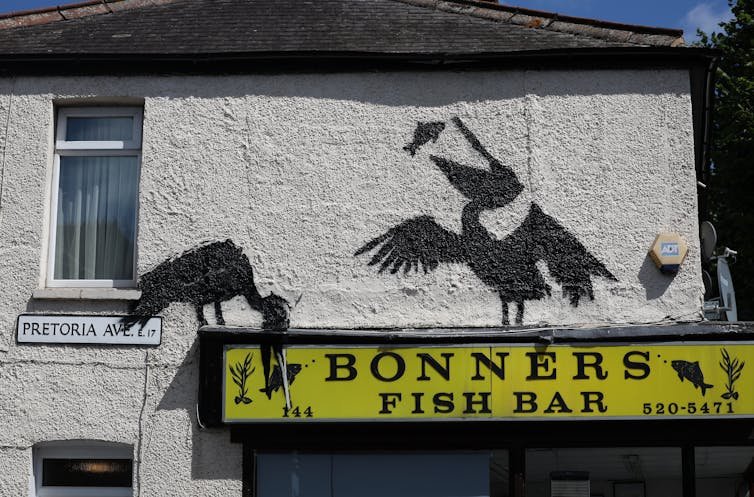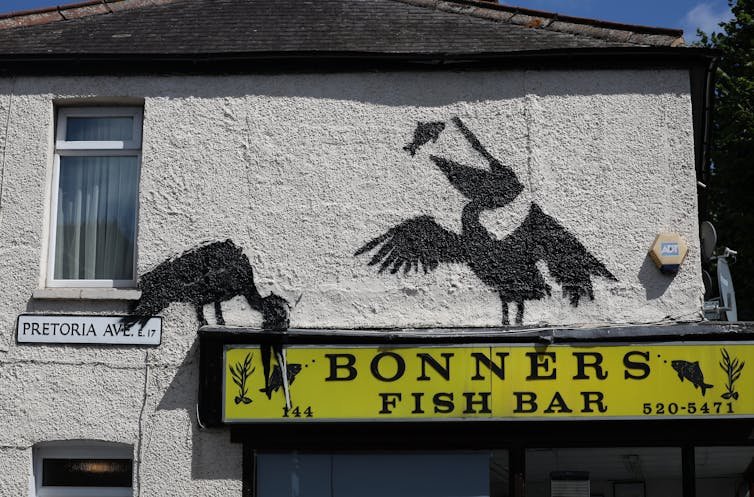Banksy fans were thrilled in August when the street artist painted nine animal-themed murals across London in the space of a few days. Speculation is rife about the deeper meanings behind the new works, but according to Pest Control (the organisation that authenticates Banksy’s work), enough has already been said.
I’m a sociologist, not an art critic, but I don’t think these murals are a profound meditation on the nature of society. Nor do I think that a coded political message will reveal itself now that all the images can be seen together. The murals have captured the public imagination not because they are artistic masterpieces, but because they play with something beyond the world of pop art: our love, fear, and fascination with animals.
In the late 1990s, American sociologists Arnold Arluke and Clinton Sanders developed the idea of a “sociozoological ladder” to explain how we perceive different animals. This ladder allows us to classify animals into categories, such as “pet”, “food” or “pest”, based on their perceived usefulness to society.
Some animals, such as dogs, are generally loved and treated well by society because they are seen as loyal and helpful. Pests and wild predators, on the other hand, are generally feared and controlled because they do not fit with society’s wishes.
We all carry this sociozoological scale within us, part of what sociologists call our “common-sense worldview”—a set of invisible rules that we follow without really thinking about them. We learn these rules from our family, school, friends, the media, and the people around us. These rules help us get along with others and make sense of the world, even if we don’t realize we’re following them.
It is Banksy’s playful use of the sociozoological scale that makes his animals so eye-catching. Just look, for example, at the way he paints rats, the animal that has become his trademark.

EPA-EFE/Andy Rain
Sociozoologically, we tend to think of rats as vermin. They are unwanted pests that society seeks to control, but we also think of them as intelligent and subversive beings. When we project our view of rats, or any other animal for that matter, onto human beings, it is called anthropomorphism.
Banksy does this a lot. When he paints rats running around with spray paint and box cutters, he is actually painting himself and the life of an underground street artist. The image clashes with the sociozoological scale of our heads, and it is this unsettling feeling that makes us sit up and take notice.
Playing with the scale
Banksy also plays with the sociozoological scale by using juxtaposition. In October 2013, while declaring himself an “artist in residence” in the United States, Banksy drove a slaughterhouse-style van filled with stuffed animals through the streets of New York.
In the piece, titled Sirens of the Lambs, a team of puppeteers pushed stuffed animal heads through the truck’s ventilation ducts. Placing stuffed animals peering through a dirty industrial meat wagon was so eye-catching because they weren’t the animals you’d expect to see.
But in these new murals, Banksy is playing with the sociozoological scale in a different way. The animals that appear across London are generally not part of cities. Whether it’s three monkeys swinging across a concrete railway bridge, a rhinoceros charging at an abandoned car, or a school of piranhas swimming around a police station, Banksy is here playing with our preconceived notions about where animals belong.
In this vein, my favourite is the ninth mural, painted on the shutters of London Zoo. Here, a watchful gorilla stands guard as he lifts the shutters to allow the silhouetted menagerie to escape. Behind the shutters are three pairs of animal eyes peering out at us from the darkness.
I don’t think Banksy is using these murals to make a political statement about keeping wild animals in captivity. But by playing with the sociozoological scale in such a fun and accessible way, Banksy makes us think about animals and their place in human society.

Looking for something good? Make a difference with a carefully curated selection of the latest releases, live events and exhibitions, direct to your inbox every fortnight on Friday. Sign up here.
#genius #Banksys #animal #murals #London
